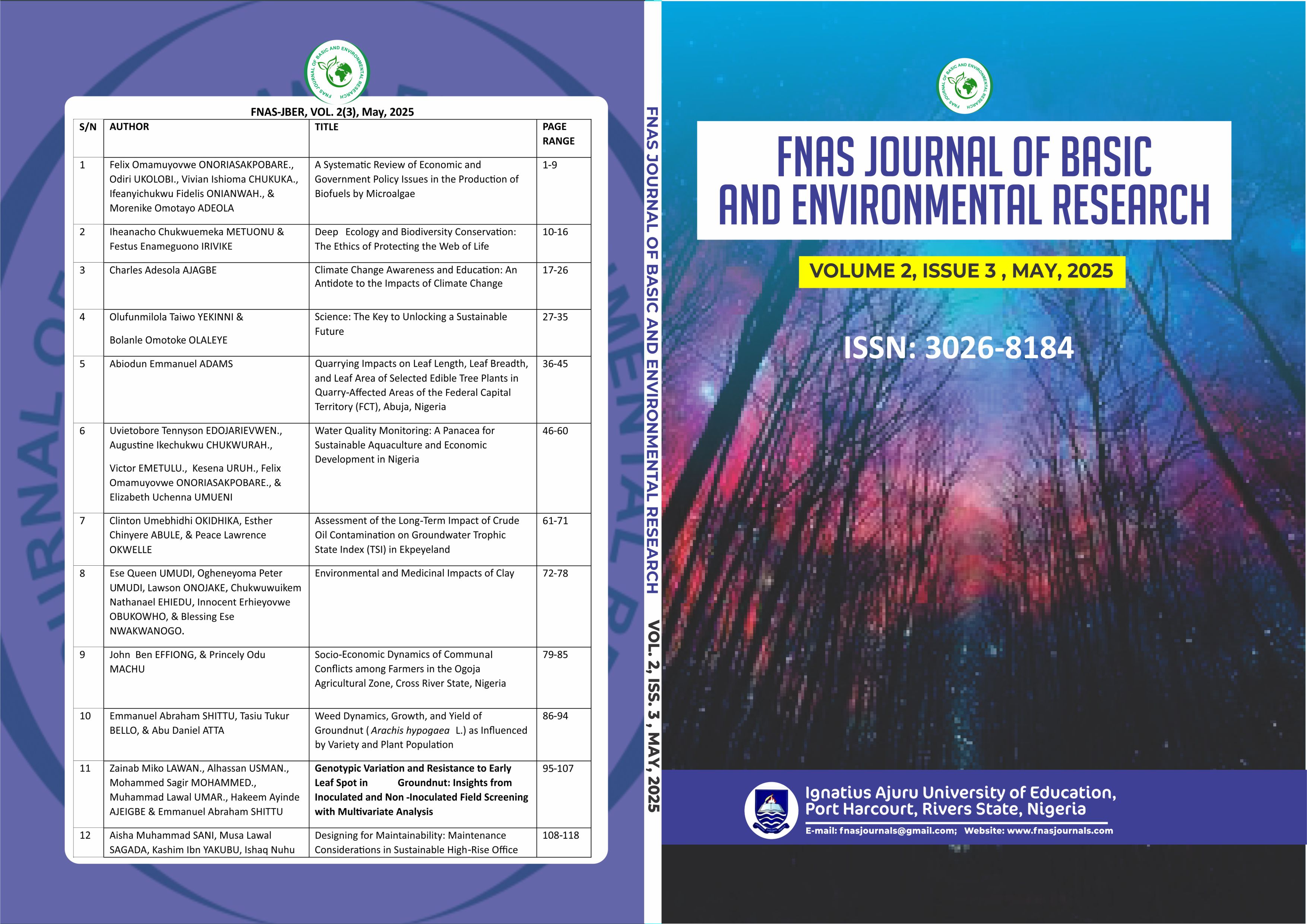Genotypic Variation and Resistance to Early Leaf Spot in Groundnut: Insights from Inoculated and Non-Inoculated Field Screening with Multivariate Analysis
DOI:
https://doi.org/10.63561/jber.v2i3.830Keywords:
Groundnut, Genetic Variability, Early Leaf Spot, Multivariate Analysis, Disease IncidenceAbstract
Early leaf spot (ELS), caused by Cercospora arachidicola, is a highly damaging foliar disease that significantly restricts groundnut (Arachis hypogaea L.) production in West Africa, often causing yield losses of over 50% due to severe leaf defoliation and decreased pod and fodder output. Developing host plant resistance provides a sustainable and affordable approach to managing ELS, particularly benefiting smallholder farmers. This study aimed to assess the genetic variation in resistance to ELS among 183 groundnut minicore genotypes under both inoculated and non-inoculated field conditions during the 2019 rainy season at two known disease hotspots of Teaching and Research farm of Bayero University Kano and Samaru, ABU Zaria. The experiment was laid out in a 14 × 13 alpha lattice design with two replications. Data were collected on agronomic and disease-related traits including days to 50% flowering, pod weight, seed weight, kernel yield, fodder weight, disease incidence, disease scores at 65 and 90 days after sowing (DAS), disease severity, shelling percentage, harvest index, and number of hills at harvest. The data were analyzed using ANOVA, Principal Component Analysis (PCA), and cluster analysis. Highly significant genetic differences (p ≤ 0.05) were observed among the genotypes for both disease resistance and yield traits under both conditions, with no significant genotype × environment interaction. Genotypes such as SAMNUT 22, ICG 12991, ICG 3240, and ICG 4540 exhibited consistently low ELS incidence and high yield performance, identifying them as promising candidates for breeding programs. In contrast, SAMNUT 26, ICGV-IS 07213, and SAMNUT 24 showed high susceptibility to ELS. PCA revealed that the first two principal components accounted for over 75% of total variation, with pod and seed weights negatively associated with disease scores at 90 DAS. Cluster analysis grouped genotypes into four distinct clusters that did not align with eco-geographical origin, suggesting that genetic diversity is not strictly geography-dependent. These findings underscore the presence of exploitable genetic variability and the feasibility of incorporating ELS resistance into groundnut improvement pipelines. The identified resistant genotypes offer valuable genetic resources for developing high-yielding, disease-resistant groundnut cultivars suitable for West African production systems.
References
Banla, E. M., Dzidzienyo, D., Diangar, M. M., Melomey, L. D., Offei, S., Tongoona, P., & Desmae, H. (2020). Molecular and phenotypic diversity of groundnut (Arachis hypogaea L.) cultivars in Togo. Physiology and Molecular Biology of Plants, 26, 1489-1504. https://doi.org/10.1007/s12298-020-00837-8 DOI: https://doi.org/10.1007/s12298-020-00837-8
Daudi, H., Shimelis, H., Mathew, I., Oteng-Frimpong, R., Ojiewo, C., & Varshney, R. K. (2021). Genetic diversity and population structure of groundnut (Arachis hypogaea L.) accessions using phenotypic traits and SSR markers: implications for rust resistance breeding. Genetic resources and crop evolution, 68(2), 581–604. https://doi.org/10.1007/s10722-020-01007-1 DOI: https://doi.org/10.1007/s10722-020-01007-1
Falconer, D. S., & Mackay, T. F. C. (1996). Introduction to Quantitative Genetics (4th ed.). Longman.
FAO (2017). Food and Agriculture Organization of the United Nations, FAOSTAT database
FAOSTAT (2023). Food and Agriculture Organization of the United Nations. https://www.fao.org/faostat/en/
Gonçalves, B., Pinto, T., Aires, A., Morais, M. C., Bacelar, E., Anjos, R., Ferreira-Cardoso, J., Oliveira, I., Vilela, A., & Cosme, F. (2023). Composition of Nuts and Their Potential Health Benefits-An Overview. Foods (Basel, Switzerland), 12(5), 942. https://doi.org/10.3390/foods12050942 DOI: https://doi.org/10.3390/foods12050942
Janila, P., Nigam, S.N., Pandey, M.K., et al. (2013). Groundnut improvement: Use of genetic and genomic tools. Plant Breeding, 132(4), 1-10. DOI: https://doi.org/10.3389/fpls.2013.00023
Kankam, F., Akpatsu, I. B., & Tengey, T. K. (2022). Leaf spot disease of groundnut: A review of existing research on management strategies. Cogent Food & Agriculture, 8, https://doi.org/10.1080/23311932.2022.2118650 DOI: https://doi.org/10.1080/23311932.2022.2118650
Shaibu, A., Miko, Z., Ajeigbe, H., Mohammed, S., Usman, A., Muhammad, M. S., & Umar, M. (2020). Genome-wide detection of markers associated with early leaf spot and pod weight in groundnut using SNP and DArT markers. Journal of Crop Improvement, 35, 522–535. https://doi.org/10.1080/15427528.2020.1846102 DOI: https://doi.org/10.1080/15427528.2020.1846102
Shaibu, A., Miko, Z., Mohammed, S., Ajeigbe, H., Usman, A., & Umar, M. (2021). Genotype × Environment Interaction for Resistance to Early Leaf Spot of Groundnut Mini Core Collections in the Savannas of Nigeria. Legume Research, https://doi.org/10.18805/LR-579 DOI: https://doi.org/10.18805/LR-579
Zongo, A., Konate, A. K., Koïta, K., Sawadogo, M., Sankara, P., Ntare, B. R., & Desmae, H. (2019). Diallel Analysis of Early Leaf Spot (Cercospora arachidicola Hori) Disease Resistance in Groundnut. Agronomy, 9(1), 15. DOI: https://doi.org/10.3390/agronomy9010015





